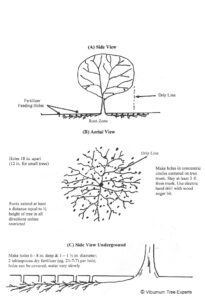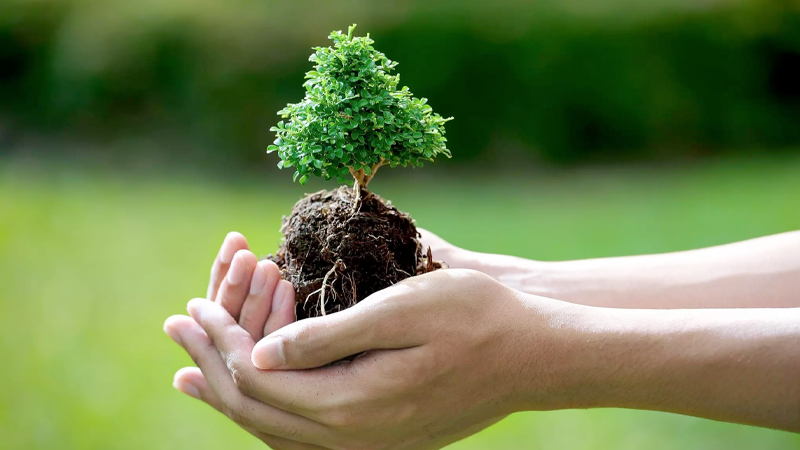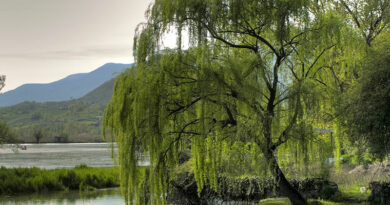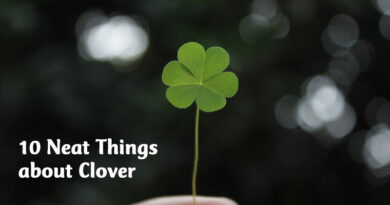Care for trees
By Mike Allen
Aeration and fertilization is a tree care process that can be done by property owners to open up the root zone of trees to air, water and nutrients – all three are essential ingredients for life in that order. So many people have the wrong idea about tree fertilization. They may toss some granular fertilizer around the base of the tree – no matter how large the tree is. This may be the way you can fertilize vegetables in your garden or grass, but not trees.
How do you know if your tree needs fertilizing? How much fertilizer do you need? What kind of fertilizer are you going to use? First you need to know what fertilizer is. It is a source of essential nutrients that when properly administered in the appropriate quantities allows for the optimal growth of the plant.
So often I hear from people who say fertilizing is not necessary because trees grow naturally in soil and are able to obtain what nutrients they need on their own. Unfortunately, this view tree care view is mostly wrong. Most of our planted trees that occur in cities, towns, rural communities and farms did not naturally grow there. Cultivated varieties of trees produced by commercial tree nurseries are appearing in greater numbers each year. In areas such as southern Manitoba the soil consists of clay and clay loam. Typically these soils are too heavy or dense for trees that have been growing in commercial nurseries on lighter soils such as loams, sandy loams and sandy clay loams. It is very difficult for most trees to uptake essential nutrients from these types of heavy soils.

Why do we want to aerate and fertilize? For two reasons:
(1) Provide a source of nutrients and energy to help restore growth of weak woody shrubs and trees.
(2) Reduce severity and duration of pest infestations and disease infections.
For most trees it is important that you or a licensed applicator inject a suitable tree fertilizer (ideally high – up to 30 per cent – in slow release nitrogen such as 20-20-20 or 21-7-7) into the soil around the tree. Licensed applicators will use their own balanced fertilizer formula. The attached illustration shows how to set up your fertilizing program following these directions. For small trees you will want to drill a pattern of one to one and a half inch diameter holes six to eight inches deep and 12 inches apart. For care of larger trees you will drill holes 18 inches apart. In both cases use an area of the yard extending at least a distance of half the height of the tree from the trunk in any direction not withstanding physical restrictions. Do not accept a single row of soil injections close to the drip line. The tree will be more or less at the centre of the pattern of holes. Stay back at least three to four feet from the trunk of large trees. Add two tablespoons of the dry tree fertilizer to each hole which can be covered if you want. Never dissolve the fertilizer in water and add it to the holes as this will be impossible to do in sandy soils. Close spacing of the holes might be necessary owing to the limited root feeding area near some trees.
If the leaves are yellowing with green veins add at least one or two teaspoons of iron chelate powder to each hole. The yellower the leaf (often seen on silver and Amur maples) the more iron chelate that needs to be added to the holes. These leaves are deficient in nitrate nitrogen and iron oxide. For coniferous evergreen trees start drilling the holes more or less at the drip line and continue outward as described above. Drill holes when the ground is dry. Do not accept a single row of soil injections close to the drip line as some products erroneously indicate on their packaging. Do not use tree root feeders or fertilizer stakes as the package directions will cause you to significantly under fertilize the tree. Badly stressed trees and newly planted trees should be fertilized with 10-52-10 or an equivalent such as bone meal. The high middle number helps to restore damaged roots.
For proper tree care, all trees would benefit from aeration and fertilization treatments. I recommend that these treatments be done at least annually (spring or fall only never in summer), and for stressed trees for at least the next two to five years depending on the severity of problems occurring in the tree. In many instances fertilization is the only way that certain diseases inside trees such as fire blight can be controlled in association with fungicidal spraying.
Michael Allen M.Sc.F., RPF (ret.) is a consulting urban forester, tree diagnostician and certified arborist. He owns Viburnum Tree Experts, a Manitoba company that provides objective assessments of the condition and the care required for trees and shrubs on home and business landscapes. His web site is www.treeexperts.mb.ca or email viburnumtrees@shaw.ca.






